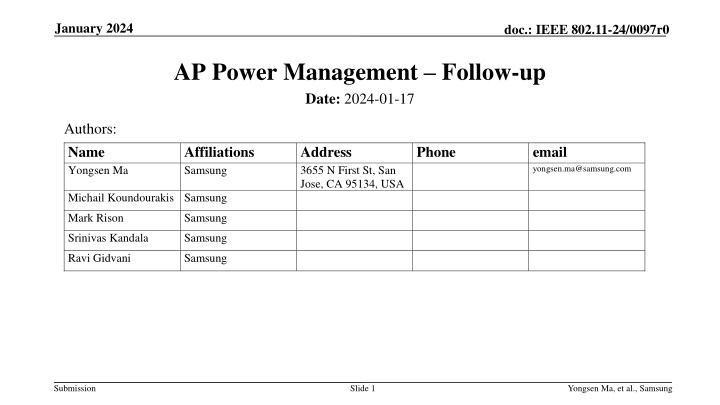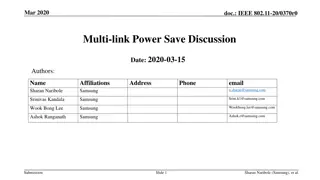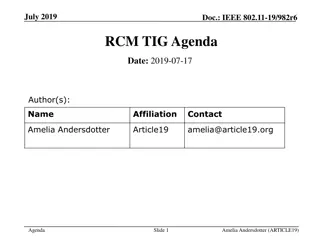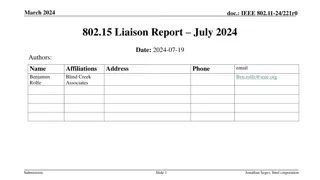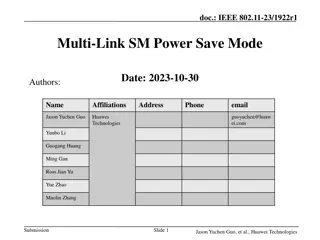IEEE 802.11-24/0097r0 AP Power Management Follow-up
The January 2024 document IEEE 802.11-24/0097r0 provides insights into AP power management, focusing on improving energy efficiency while maintaining functionality. It introduces a scheduled AP power save proposal to address power save levels and performance requirements through states like Doze, Listen, and Reduced Capability. The document outlines procedures and operations for APs and non-AP STAs, including schedule management and state transitions to enhance energy efficiency in wireless networks.
Download Presentation

Please find below an Image/Link to download the presentation.
The content on the website is provided AS IS for your information and personal use only. It may not be sold, licensed, or shared on other websites without obtaining consent from the author.If you encounter any issues during the download, it is possible that the publisher has removed the file from their server.
You are allowed to download the files provided on this website for personal or commercial use, subject to the condition that they are used lawfully. All files are the property of their respective owners.
The content on the website is provided AS IS for your information and personal use only. It may not be sold, licensed, or shared on other websites without obtaining consent from the author.
E N D
Presentation Transcript
January 2024 doc.: IEEE 802.11-24/0097r0 AP Power Management Follow-up Date: 2024-01-17 Authors: Name Yongsen Ma Affiliations Samsung Address 3655 N First St, San Jose, CA 95134, USA Phone email yongsen.ma@samsung.com Michail Koundourakis Samsung Mark Rison Samsung Srinivas Kandala Samsung Ravi Gidvani Samsung Submission Slide 1 Yongsen Ma, et al., Samsung
January 2024 doc.: IEEE 802.11-24/0097r0 Abstract There are requirements and recommendations to improve the energy efficiency of APs [1-4]. The previous contribution [5] presents A brief summary of existing protocols and proposals [6-15] for scheduled and unscheduled AP power save, for example, utilizing TWT, MLD, EMLSR, etc. A proposal of scheduled AP power save to improve the energy efficiency of APs while limiting the negative impact on functionality and performance. This contribution is a follow-up on scheduled AP power save [5] Procedures and operations for AP and non-AP STAs Information elements and options for schedule, power state, power state transition, capability, and management information Submission Slide 2 Yongsen Ma, et al., Samsung
January 2024 doc.: IEEE 802.11-24/0097r0 Recap: AP Power Save Proposal The AP balances power save levels and performance requirements by adjusting its schedule & capability. In the scheduled time window, the AP may be in Doze state: The AP sends Absence Notification in Beacon, Probe Response, or Action frames to other STAs. The AP remains in the doze state and is absent during the scheduled time window. Listen state: The AP remains in the listen state performing CCA or signal detection. The AP may respond to legacy devices or on-demand data in deferred or immediate manners. This state allows everything on the AP to be turned off except for RX signal detection and this may mean the host in the AP is in low power state and the AP would not transmit. Reduced capability: The AP may use a reduced capability subset, such as single antenna, reduced BW, etc., instead of utilizing the full capability set. Submission Slide 3 Yongsen Ma, et al., Samsung
January 2024 doc.: IEEE 802.11-24/0097r0 Procedures and Operations Basic operations The AP sends out schedule in Beacons and turns into doze/listen state based on the schedule. STAs receive the schedule and may turn to doze state during the time window when the AP is in doze/listen state. Presence Request or schedule change STAs may send Presence Request in probe request or Action frames to the AP. The AP may accept the request and send the confirmation to STAs in Beacon and response frames. The AP may also change the schedule itself without any Presence Request from other STAs. Schedule update If the schedule is changed: the AP shall send the new schedule in Beacons; The AP may send the new schedule in Action/Response frames during the Active state according to the previous schedule. STAs need to receive Beacons and Action frames to know the current schedule information. STAs may send schedule request to the AP asking for the current schedule. Note that the AP may not receive the request if the AP is in doze state. One link of an AP MLD may send the schedule & capability info. of other links. Similarly for RNR and multi-AP. Submission Slide 4 Yongsen Ma, et al., Samsung
January 2024 doc.: IEEE 802.11-24/0097r0 Procedures and Operations (Cont.) Some rules to avoid potential issues The AP should not go into doze state if there is any legacy device associated STAs should wait for Beacons to know the AP s status before taking other actions, especially for STAs newly-arrived or in PS Backoff counters should be maintained correctly, given AP in doze state may cause confusion about whether the channel is busy or idle. Suspend backoff counter for UHR devices. The AP may have a schedule to be in Active state with 20MHz-only primary channel and single antenna to meet power saving requirements while supporting legacy devices and on-demand data. The signaling to inform peers is TBD, only applicable to new STAs STAs in power save mode STAs need to know the correct schedule and state of the AP, especially if the schedule is changed Operations of APs: send any update in Beacons (don t change it unless STAs are aware, the AP should decide it directly or indirectly) Operations of STAs: listen to Beacons or send schedule request upon waking up Schedule with the AP in listen state If listen state is interrupted/stopped: only the current time window, or the whole schedule instance Can be used together with unscheduled AP power save, providing predictable behaviors for STAs Other procedures are TBD: MLD, multi-AP, synchronization, roaming, P2P, etc. Submission Slide 5 Yongsen Ma, et al., Samsung
January 2024 doc.: IEEE 802.11-24/0097r0 Information Elements: Schedule and Capability Info. The AP needs to specify the schedule and capability: when, how long/often, what state/capability Option 1: define new information elements for schedule, power state, and capability information Schedule info Power state info Extension (capability info) ID and other info Start time/offset Duration Interval Count Power state Power state transition Extension present Supported channel width Supported NSS Example 1: AP in doze state 2304 51200 102400 255 Doze N/A 0 N/A N/A Example 2: AP in 20MHz-only and NSS=1 mode 2304 20MHz-only (NSS=1)-only 1 51200 102400 255 Active N/A 1 1 Submission Slide 6 Yongsen Ma, et al., Samsung
January 2024 doc.: IEEE 802.11-24/0097r0 Information Elements: Schedule and Capability Info. (Cont.) The AP needs to specify the schedule and capability: when, how long/often, what state/capability Option 2: reuse existing information elements. In addition, define new information elements for power state and capability information. Example 1: reuse TWT element Schedule info (reuse TWT) Power state info (outside of TWT) Extension (capability info) ID and other info Power state Power state transition Extension present Supported channel width Supported NSS Submission Slide 7 Yongsen Ma, et al., Samsung
January 2024 doc.: IEEE 802.11-24/0097r0 Information Elements: Schedule and Capability Info. (Cont.) The AP needs to specify the schedule and capability: when, how long/often, what state/capability Option 2: reuse existing information elements. In addition, define new information elements for power state and capability information. Example 2: reuse TID-To-Link Mapping element in broadcast frames Schedule and link info (reuse TID-To-Link Mapping) Power state info (for each link) Extension (capability info) ID and other info Power state Power state transition Extension present Supported channel width Supported NSS Repeat if applicable, or add subfields for periodic/long-term patterns Submission Slide 8 Yongsen Ma, et al., Samsung
January 2024 doc.: IEEE 802.11-24/0097r0 Information Elements: Schedule and Capability Info. (Cont.) The AP needs to specify the schedule and capability: when, how long/often, what state/capability Option 2: reuse existing information elements. In addition, define new information elements for power state and capability information. Other examples: similar concept to reuse Quiet element or Schedule element Submission Slide 9 Yongsen Ma, et al., Samsung
January 2024 doc.: IEEE 802.11-24/0097r0 Information Elements: Presence/Schedule Request Procedures and IEs needed for STAs/APs to manage the AP s schedule & capability Option 1: Presence/Schedule Request in a single IE with a request type field ID and other info Request type Present for certain request type STAs to request the AP not entering a certain state, can either add new request types or use request type 2 with the requested schedule attached 0 STAs request the AP to disable AP power save 1 STAs request the AP to send out the current schedule 2 STAs request the AP to use a certain schedule attached 3 STAs cancel a previous Presence/Schedule Request Option 2: Presence/Schedule Request in separate IEs STAs can send Schedule Request IE in Probe Request or Action frames to request for the current schedule. STAs can send Schedule & Capability IE in Probe Request or Action frames to request to disable AP power save or request for a certain schedule. The AP can send Schedule & Capability IE in Beacon or Action frames to STAs to confirm/reject the request. Can use existing frames or add subfields, e.g., any legacy or latency sensitive frame can disable AP power save. Submission Slide 10 Yongsen Ma, et al., Samsung
January 2024 doc.: IEEE 802.11-24/0097r0 Conclusion This contribution gives a follow-up on scheduled AP power save [5] Procedures and operations for AP and non-AP STAs Information element options for schedule, power state, capability, and management info. Submission Slide 11 Yongsen Ma, et al., Samsung
January 2024 doc.: IEEE 802.11-24/0097r0 References [1] Dorothy Stanley, Liaison statement from Wi-Fi Alliance re: energy efficiency, IEEE 802.11-23/0917r0, 2023 [2] Amelia Andersdotter, et al., 802.11 AP Power Save PAR addition proposal, IEEE 802.11-23/0244r1, 2023 [3] Amelia Andersdotter, et al., Green AP and resilience requirements for home networks, IEEE 802.11-22/1790r0, 2022 [4] Lili Hervieu, et al., A Perspective on UHR Features for Operator Residential Deployments, IEEE 802.11-22/1809r0, 2022 [5] Yongsen Ma, et al., AP Power Management, IEEE 802.11-23/1835r0, 2023 [6] Liwen Chu, et al., AP MLD power management, IEEE 802.11-23/0015r0, 2023 [7] Alfred Asterjadhi, et al., Considerations for enabling AP power save, IEEE 802.11-23/0010r0, 2023 [8] Guogang Huang, et al., Considering Unscheduled AP Power Save, IEEE 802.11-23/0225r0, 2023 [9] Stefan Aust, AP Power Saving, IEEE 802.11-11/0046r2, 2011 [10] Stefan Aust, TGah Use Case AP Power Saving in Smart Grid, IEEE 802.11-11/0273r0, 2011 [11] Xiaofei Wang, et al., AP Power Saving, IEEE 802.11-17/0728r2, 2017 [12] Xiaofei Wang, et al., On AP Power Saving Usage Model, IEEE 802.11-17/1388r2, 2017 [13] Jay Yang, et al., MLD AP Power-saving(PS) Considerations, IEEE 802.11-20/1115r6, 2020 [14] Kyumin Kang, et al., Considerations on Soft AP Power Saving, IEEE 802.11-21/0885r1, 2021 [15] George Cherian , et al., Enabling AP power save_follow up, IEEE 802.11-23/2040, 2023 Submission Slide 12 Yongsen Ma, et al., Samsung
